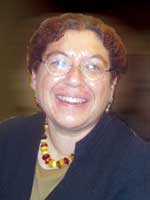
Reach Out & Read: A Pediatrician’s
Perspective
by Perri Klass, MD
As a practicing pediatrician,
I know how busy the health supervision visit (also
known as the check-up) can be. There’s a long list of topics to cover, shots to
give, measurements to take, sage advice to dispense,
and questions to answer. But over the past fifteen years,
more and more pediatricians have added early literacy
and reading aloud to that long list, routinely talking
with the parents of babies, toddlers, and preschoolers
about how to help their children grow up enjoying books.
Fifteen years ago, at what was the Boston City Hospital,
a couple of pediatricians, Barry Zuckerman, MD, and Robert
Needlman, MD, together with an early childhood educator,
Kathleen Fitzgerald Rice, MSEd, developed a simple strategy
for literacy promotion in a pediatric clinic—the
Reach Out and Read model. From that one site in that
one clinic, which continues to serve a large urban population,
including many children growing up in poverty and many
new immigrants and refugees, Reach Out and Read has spread
to include programs at more than 2000 clinics, health
centers, hospitals, and private practices. I have been
involved with the program for the past ten years, helping
my fellow pediatricians—and family physicians and
nurse practitioners—incorporate this model into
their daily professional practice.
Reach Out and Read has 3 components.
It starts in the waiting room (where our patients and
their parents often sit for far too long) with volunteers
reading aloud, with books for the children to look
at, with displays about reading and literacy. Second,
during the checkup, the doctor gives some age-appropriate
advice about reading aloud, and third, the doctor gives
the child a beautiful new book to take home—age-appropriate, culturally
appropriate, and ready to be enjoyed. The program is
aimed at children from six months through five years,
and if we do it right—that is, if they keep all
their well-child appointments and we manage to give a
book at each visit—that’s ten books in the
home by kindergarten age, each coming with advice and
guidance.
For example, when I see a
six-month-old, I offer her a board book—small for small hands, hard and chewable,
and generally illustrated with pictures of faces. As
she grabs it and starts to chew on it, I assess her development—can
she sit along, fix and follow, reach and grab—and
I talk to her parent about how normal it is for a baby
this age to explore the world by chewing on things. I
might model pointing and naming as I hand over the book—“This
is the baby! This is the baby’s nose!”—and
I make sure to emphasize that reading to children is
important, even before they can talk. I try to help parents
see that when a young child, eager for a parent’s
undivided attention, eager for the sound of the parent’s
voice, comes to associate that desirable contact with
books, a positive association with books is formed which
can help that child grow up enjoying books, and arrive
at school with the early literacy skills she needs in
order to tackle the job of learning to read.
As the children grow, the
advice changes—I might
reassure the mother of a two-year-old that it’s
normal if he doesn’t sit still for the whole story.
I might discuss books in the context of bedtime rituals
and sleep issues. But the overall message is always there:
this is something good—and something important—that
you can do to help your child.
Many teachers have told me
that they can see on the first day—or sometimes, in the first hour—of
kindergarten or first grade which children have grown
up with books. By putting books into more homes, by encouraging
parents to start reading aloud early, Reach Out and Read
hopes to make books a part of every healthy childhood.
Research studies have shown us that the program increases
parent reading aloud, leads to more positive attitudes
towards books and reading, and improves the language
scores of children from about eighteen months of age.
On a personal level, I love
practicing medicine with a book in my hand. I love
the children’s responses—from
the six-month-old who chews on his new book right away
to the preschooler who proudly describes what she sees
happening on the pages. And I love watching the children
go home, holding their books, taking words and pictures
and the pleasures of reading aloud into their homes and
into their lives.#
For more information visit www.reachoutandread.org.
Perri Klass, M.D. is a
practicing pediatrician & assistant
professor of pediatrics, Boston U. School of Medicine.
She is the President and Medical Director of Reach
Out and Read.
